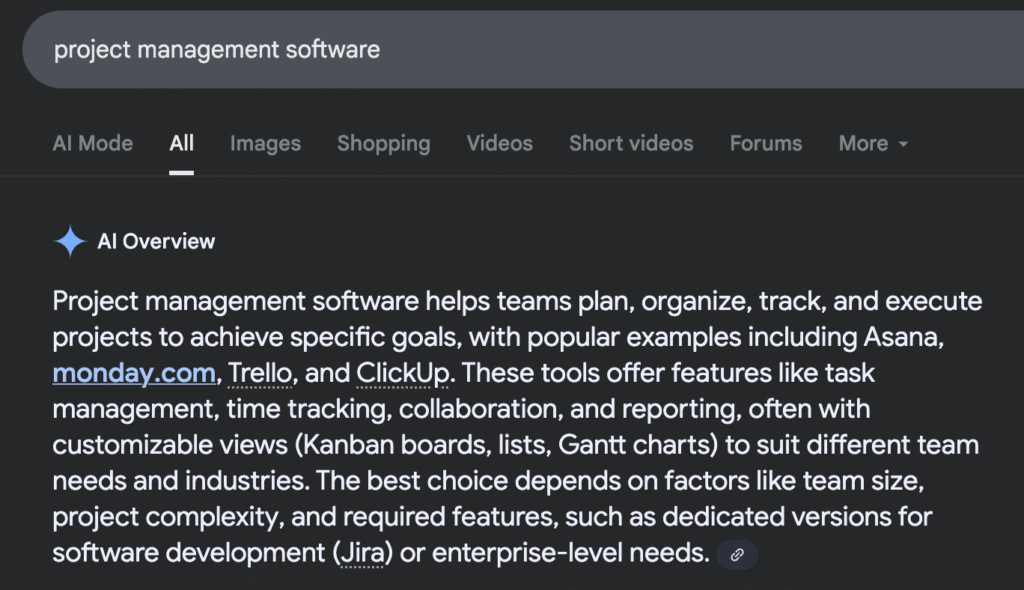While you’re busy optimizing for Google, your competitors are already getting mentioned by ChatGPT, Perplexity, and Claude in AI-generated responses. The question isn’t whether you should adapt to this new reality—it’s how quickly you can position your clients for success across traditional search engines AND generative AI platforms.
As AI tools reshape how people discover information, three distinct optimization approaches have emerged: SEO (Search Engine Optimization), GEO (Generative Engine Optimization), and AEO (Answer Engine Optimization). Each serves a different purpose, targets different platforms, and requires unique strategies.
For SEO specialists, brand managers, and agencies, understanding these differences is essential for delivering results in an AI-first world. This guide breaks down what you need to know to stay ahead of the curve and provide comprehensive optimization services that actually work.
SEO vs GEO vs AEO
While these three acronyms might sound like marketing jargon, they represent fundamentally different approaches to visibility in our AI-driven search landscape. Traditional SEO remains the foundation: optimizing content to rank high in traditional search engine results pages (SERPs) like Google and Bing. The goal is to secure those coveted top positions that drive clicks to your website.

What is GEO in SEO?
While SEO focuses on ranking algorithms and keyword targeting, GEO is about authority, expertise, and creating content that AI tools consider citation-worthy.
Think of it this way: SEO asks, “How can I rank higher?” GEO, on the other hand, asks: “How can I become the authoritative source that AI tools reference?” The metrics are different, the content approach is different, and the expected outcomes are fundamentally different.
What About AEO?
Answer engine optimization (AEO) bridges the gap between traditional SEO and the new AI landscape. AEO focuses on optimizing content to appear in featured snippets, AI Overviews, and voice search results.

The key difference is that AEO targets existing search infrastructure (Google’s featured snippets, Bing’s AI chat) while GEO targets standalone AI tools that operate independently from traditional search engines.
AEO strategies include:
- Structured content: Using question-and-answer formats that answer engines can easily extract
- Schema markup: Implementing FAQPage and HowTo schema to help AI understand content structure
- Concise answers: Creating content that directly addresses user questions in 50-300 words
- Authority signals: Building E-E-A-T (Experience, Expertise, Authoritativeness, Trustworthiness) that answer engines recognize
Similarities Between SEO and GEO
Despite their differences, SEO and generative engine optimization share several foundational elements:
- Content quality remains king. Both approaches reward well-researched, comprehensive content that demonstrates expertise. Whether you’re trying to rank on Google or get cited by ChatGPT, authoritative content is essential.
- E-E-A-T signals matter. Google’s Experience, Expertise, Authoritativeness, and Trustworthiness framework isn’t just for traditional SEO. AI tools also prioritize content from established experts and trusted sources.
- Technical optimization helps both. Fast-loading websites, clean code, and proper site structure benefit both search engine crawlers and AI bots that analyze web content.
- User intent drives strategy. Understanding what users are actually looking for—whether they’re searching Google or asking ChatGPT—remains fundamental to both approaches.
Differences Between SEO and GEO

The distinctions become clear when you examine what each approach prioritizes:
- Platform focus: SEO targets search engines with ranking algorithms, while GEO targets AI models with training data and real-time web access.
- Success metrics: SEO measures rankings, clicks, and traffic. GEO measures mentions, citations, and brand visibility within AI responses.
- Content approach: SEO optimizes for keywords and search intent. GEO optimizes for natural language and conversational queries that people actually ask AI tools.
- Competition dynamics: SEO competes for finite ranking positions (1st, 2nd, 3rd place). GEO competes for mind share—multiple brands can be mentioned in a single AI response.
- Optimization tactics: SEO optimization focuses on technical factors like page speed, internal linking, and keyword density. GEO emphasizes content depth, source credibility, and expertise demonstration.
Why It’s Important to Focus on ChatGPT Optimization
With an SEO strategy, you most likely focus on your ranking on Google. The same principle applies to GEO. Nowadays, there are different large language models, not just ChatGPT. There’s Claude, Google Gemini, Perplexity, Grok, and more.
But if you’re just starting with your GEO strategy, it’s best to focus on one first. And that’s ChatGPT. Here are the reasons why…
ChatGPT is the Most Popular LLM
According to recent data, 69% of respondents use ChatGPT. Many people have even abandoned Google and are now using ChatGPT for most of their questions.
ChatGPT also has the most diverse user base — ranging from students to writers, marketers, and engineers.
That’s why Genrank supports ChatGPT solely (as of now), so you can be laser-focused with how your brands appear on ChatGPT.
Pro tip: Try Genrank for free and see how ChatGPT mentions your brand.
ChatGPT Has Web Search Functionality
ChatGPT can access real-time web content through its search functionality. This means your latest content, product updates, and current information can be discovered and cited by ChatGPT when users ask relevant questions.
While most of the LLMs now have a web search feature, ChatGPT was the first to implement it.

This web search capability creates immediate optimization opportunities. When you publish new content or update existing articles, ChatGPT can potentially reference this information in responses within days or weeks, rather than waiting for model retraining cycles that other AI tools require.
ChatGPT’s Custom GPT Ecosystem Creates Niche Optimization Opportunities
ChatGPT’s Custom GPT marketplace allows specialized AI assistants trained for specific industries and use cases. This creates unique optimization opportunities where you can target niche Custom GPTs that serve your exact audience.
For example, there are Custom GPTs specifically for marketing strategy, software development, financial planning, and hundreds of other professional niches. When your content gets cited by these specialized GPTs, you’re reaching highly qualified prospects who are using AI tools specifically designed for their professional needs.
How to Integrate GEO in SEO
The good news for marketing professionals is that GEO doesn’t require abandoning your existing SEO strategy. Instead, it builds upon SEO fundamentals while adding new techniques specifically designed for AI visibility.
Here’s how to integrate both approaches effectively.
Answer Real User Questions
The foundation of successful GEO integration starts with understanding the questions your audience actually asks AI tools—which often differ significantly from their Google search queries.

When someone searches Google, they might type “project management software.” But when they ask ChatGPT, they’re more likely to ask, “What’s the best project management software for a startup with remote team members who need time tracking and budget management?”
Add FAQs to Blog Posts
Strategic FAQ implementation serves as a bridge between traditional SEO and AI optimization. Done correctly, FAQs can capture featured snippets, feed AI training data, and provide the question-answer pairs that AI tools prefer to reference.
Implementation strategy:
- Add 5-7 comprehensive FAQs to every blog post, focusing on questions that extend beyond your main content
- Use natural, conversational phrasing that reflects how users actually ask questions
- Structure each answer to be complete and standalone—AI tools often extract FAQ content directly
- Implement the FAQPage schema markup to help both search engines and AI understand your content structure
The key is creating FAQs that would genuinely help someone learn about your topic, not just keyword-stuffed questions designed to game search algorithms.
Create Authority-Driven Content
AI tools prioritize content that demonstrates clear expertise and authority. Unlike traditional SEO where you might optimize for specific keywords, GEO requires creating content that establishes you as the definitive source on your topic.
- Depth over breadth: Instead of creating multiple thin articles targeting different keywords, develop comprehensive resources that thoroughly cover your topic. AI tools are more likely to cite a well-researched 3,000-word guide than five 600-word posts.
- Original research and data: Publish industry surveys, case studies, or original analysis that other content can’t replicate. AI tools specifically look for unique insights and data when generating responses about industry trends or best practices.
- Expert bylines and credentials: Clearly establish author expertise through detailed bio sections, credentials, and examples of relevant experience. AI tools increasingly factor author authority into their citation decisions.
- Source transparency: Include clear citations to reputable sources, link to relevant studies, and acknowledge limitations in your analysis. This transparency builds the credibility that AI tools use to assess content quality.
Optimize Technical Infrastructure for AI Accessibility
The technical foundation that supports good SEO also enables AI accessibility, but with some additional considerations:
- Structured data implementation: Beyond basic schema markup, implement comprehensive structured data that helps AI understand your content’s context, purpose, and relationship to other topics.
- Site speed and accessibility: AI crawlers, like search engine bots, prefer fast-loading, accessible websites. But they may be more sensitive to JavaScript-heavy sites or complex navigation structures.
- Content hierarchy: Use clear heading structures (H2, H3, H4) that both search engines and AI can easily parse to understand your content’s organization and key points.
- Internal linking strategy: Create logical content clusters that help AI understand the relationship between your different pieces of content and establish topical authority across related subjects.
The goal is to make your expertise easily discoverable and understandable by both traditional search crawlers and AI systems analyzing web content for training data and real-time responses.
Conclusion
Traditional SEO remains essential for driving traffic and establishing baseline visibility. AEO helps you capture the growing featured snippet and voice search market. GEO positions you for the AI-driven future where brand mentions in ChatGPT responses become as valuable as Google rankings.
Ready to future-proof your marketing strategy for the AI era? The clients who invest in comprehensive optimization today will dominate tomorrow’s AI-driven discovery landscape.
FAQs
What is the difference between GEO and AEO and AIO?
GEO focuses on getting cited in AI-generated responses from tools like ChatGPT and Claude. AEO targets featured snippets and AI Overviews in traditional search engines. AIO is a broader term encompassing any optimization for AI systems, including both GEO and AEO strategies.
What is the difference between SEO and AEO?
SEO optimizes for rankings in search engine results pages to drive clicks to your website. AEO optimizes for direct answers in featured snippets, AI Overviews, and voice search, where users get information without clicking through.
How is AEO different than SEO?
AEO prioritizes answer formats and zero-click results, while SEO prioritizes clickable rankings. AEO content must be structured for easy extraction by answer engines, using question-answer formats and concise responses. SEO content can be broader and focuses on comprehensive keyword coverage rather than specific answer optimization.
